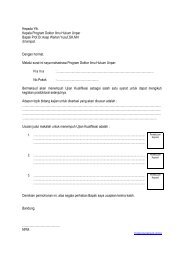TOWARDS CLASSIFYING CLASSICAL BATIK IMAGES - Unpar
TOWARDS CLASSIFYING CLASSICAL BATIK IMAGES - Unpar
TOWARDS CLASSIFYING CLASSICAL BATIK IMAGES - Unpar
Create successful ePaper yourself
Turn your PDF publications into a flip-book with our unique Google optimized e-Paper software.
1992). Fourier descriptor methods: (1) The image is presented to Canny edge detector. (2) The<br />
centroid of the edge points is computed. (3) Compute the distance of each sample edge point to<br />
the centroid. (4) Apply Discrete Fourier Transform to the result of step 3. (5) Normalize the<br />
coefficients of step 4 by dividing each coefficient (Fi) with the first coefficient (F0) and store<br />
them as the features. Moments invariant method: Three order moments are computed from the<br />
preprocessed images and the result are stored as the feature. Elastic template matching methods:<br />
(1) The image is presented to Canny edge detector. (2) The output of step 1 (an array containing<br />
1s and 0s) is stored as the feature.<br />
Classification using k-Nearest Neighbor. The basic idea of the classification process is adopted<br />
from (Sheikholestami et.all, 1998) with some modification. The classification process consists of<br />
four main steps: (1) Compute the new image shape and texture features and the similarity values<br />
between the new image and all training images using shape and texture features. Find two sets of<br />
training images that are most similar to the new image in terms of the ornaments shape and the<br />
image texture. (2) Combine the two sets resulting in step 1. Let Rq be the new set. (3) Compute<br />
the overall image similarities of images in Rq using multi-layer back-propagation neural network.<br />
(4) Sort the new similarity values obtained from step (3), and using k-nearest neighbor<br />
classification technique, determine the class of the new image.<br />
Computing image similarities. Texture feature. For content-based, the distance between 2<br />
images is computed using Euclidean distance. Then the distance is transformed into similarity<br />
value as follows:<br />
SimValue(i,j) = 1 – distance(i,j) / max of Distance (1)<br />
where i,j denoting the index of the two images being compared and Distance is a set of all<br />
distance between images. For region-content-based, the method in (Bartolini, 2001) is applied.<br />
Shape feature. The main steps are: (1) The new image is segmented into windows and features<br />
are generated from each window. (2) The feature of a training image is compared to the feature<br />
of each new image windows. (3) For moments invariant and Fourier descriptor, the similarity<br />
value is computed using Eq. 1. For elastic template matching: similarity is computed by<br />
determining the correlation between the two features. The largest value among all similarity<br />
values of the windows is selected as the similarity value between the new image and training<br />
image.<br />
5




